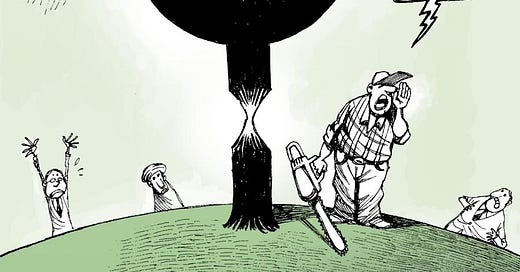Something very strange is happening in the financial markets. The precipitous drop in stock prices that was ignited by Trump’s tariff policies is only part of puzzle. We have had bear markets before and we will have them again but this seems peculiar. Of course, we all remember the Covid lockdown crash. The S&P 500 index lost about one-third of its value, from peak to through. The Great Financial Crisis is still etched in the mind of many investors. The market dropped about 50%, during that period. Old-timers still remember the October 19th, 1987 crash when the S&P 500 declined 22.6% in just one day.
The current market situation is cause for concern because it is so unprecedented. Market corrections and crashes are inevitable. However, when stock prices fall, the vast majority of times, long bond prices rise. The market usually anticipates lower interest rates as central bankers attempt to reinvigorate the economy by cutting rates. This is why long bonds are such a good hedge. The fact that bonds failed to rally during the Covid crash is explainable by the fact that rates were at all time lows and unsustainable. Everyone knew inflation was going to rise due to rampant money creation and the supply chain issues created by the pandemic. The ten year yield on U.S. Treasuries was about 1.25% and inflation was headed to a peak of 9%. Yields are now over 4% and inflation had fallen, by some measures, to below 3% before the Trump tariff blunder. Long bond prices have recently fallen 6% in one week. Something strange is happening.
Adding to the turmoil is the fact that the U.S. dollar index fell 10% since the beginning of the year. This is a huge move in currency markets which tend to be more stable on a percentage change basis than stocks or long term bonds. Trump’s so-called Mar-a-Logo Accord has a falling dollar as part of its strategy as the President and his advisors believe that most foreign countries have engaged in currency manipulation against the U.S. (A belief I find ridiculous). The Mar-a-Largo Accord isn’t really an accord at all like the Plaza Accord was in 1985. That accord was a signed agreement by the U.S., major European nations and Japan. The Mar-a-Lago accord is unilateral. After the Plaza Accord was signed, the U.S. dollar fell 26% over the next two and a half years. The U.S. dollar could fall significantly further than it already has.
The yield curve inversion recession indicator has been widely discussed. In fact, I have been watching it since the early 1980s, when it was considered a crackpot theory. Since then, it has gained widespread acceptance, only to be doubted again as the recession expected in 2023 never materialized. No indicator is perfect. However, economists and macro analysts had it wrong. The recession clock does not begin when two year Treasury yields rise above ten year rates but when the yield curve de-inverts. A year ago the ten year to two year spread was about -65 basis points or -0.65%. Now it is about +50 basis points or +0.50%.
There are two other factors that I use in “my” yield curve indicator that were not present when many forecasted a 2023 recession. One was that short rates were not significantly above expected inflation. In reality, the Fed Funds rate was drastically below inflation. Rates were extremely low and were really just normalizing.
Also, credit spreads; the yield difference between corporate bonds and Treasury bonds of similar term to maturity usually widen significantly. Corporate bond players tend to be overwhelmingly institutional, and bluntly, far more sophisticated than equity managers. At the onset of economic weakness they begin to worry that companies will struggle and possibly default on their debt. They sell their corporate positions causing prices to fall and yields to rise. The spread between U.S. high yield debt and Treasuries has gone from 2.66% to 4.26% in just seven weeks.
All the factors are in place to forecast an economic downturn with an over 50% probability. The additional uncertainty caused by the current administration’s trade policy is like lobbing a hand grenade into a crowded bar to settle a disagreement about who paid for the last rounds of drinks.
We could be seeing the beginning of the end of U.S. dollar dominance. When things are this chaotic, new problems occur which were not forecast. Could we get a banking crisis? It is quite possible. Frankly, I am concerned that even the traditionally conservative Canadian banks are seeing significant declines in their stock prices. Investors appear to be concerned about the potential for a large increase in loan losses.
A wise person once told me to hope for the best and prepare for the worst. An even wiser professor of mine told me to always choose the strategy where the worst case scenario was survivable. Having large cash positions may not be the best investment strategy, but for the next few months it will alleviate a lot of anxiety. Given the determination of the U.S. to sink its own currency, short term Euro bonds may be the way to go.




